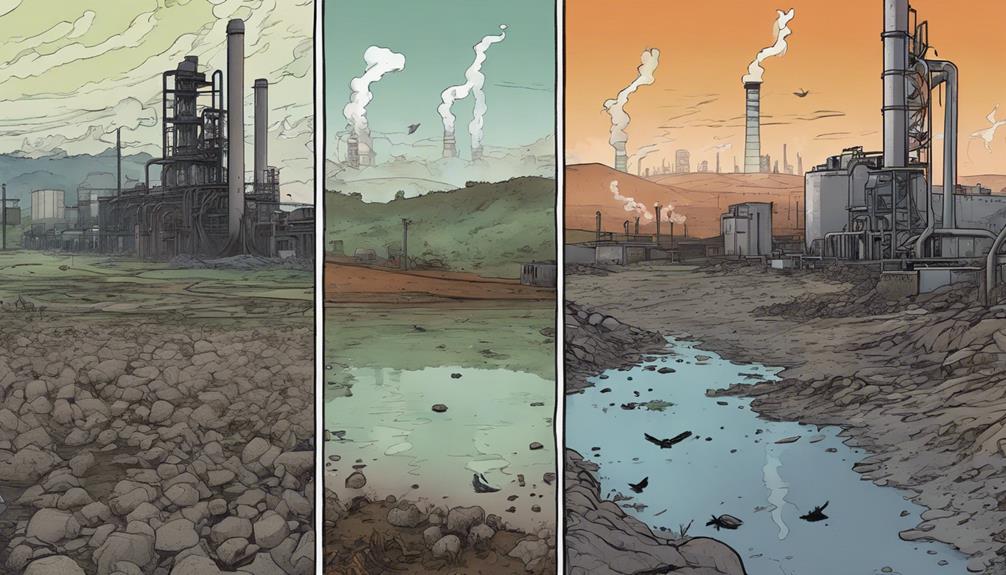As we explore geothermal energy as a cleaner alternative to fossil fuels, we're uncovering its hidden environmental impacts. Drilling and extraction release greenhouse gases, contributing to global warming. Land subsidence and seismicity are also major concerns. Additionally, hot water extraction poses water pollution risks, contaminating aquatic ecosystems. Geothermal fluids contain harmful substances like heavy metals, disrupting nutrient cycles and altering water pH levels. And let's not forget noise and visual disturbances. It's clear that geothermal energy's environmental consequences are more complex than we thought – and there's more to the story.
Key Takeaways
- Geothermal energy production contributes to greenhouse gas emissions, albeit at a lower rate than fossil fuels, during drilling and extraction.
- Land subsidence and induced seismicity are significant concerns due to fluid extraction and injection, threatening environmental stability.
- Water pollution risks are high due to hot water extraction, cooling water withdrawal, and discharge of harmful substances into aquatic ecosystems.
- Geothermal fluids contain heavy metals and other harmful substances that disrupt nutrient cycles, alter water pH levels, and threaten ecosystem stability.
- Despite being a cleaner alternative to fossil fuels, geothermal energy's hidden environmental impacts must be understood and mitigated to ensure sustainable production.
Environmental Consequences Uncovered

As we delve into the world of geothermal energy, we're compelled to confront the stark reality that this seemingly clean source of power comes with a myriad of hidden environmental consequences. While it's true that geothermal energy offers a cleaner alternative to fossil fuels, it's not without its drawbacks.
We're talking about greenhouse gas emissions during drilling and extraction, land subsidence, water pollution, and noise and visual impacts on the environment. It's essential that we grasp the thorough environmental impact of geothermal energy to mitigate these effects.
Greenhouse Gas Emissions Revealed
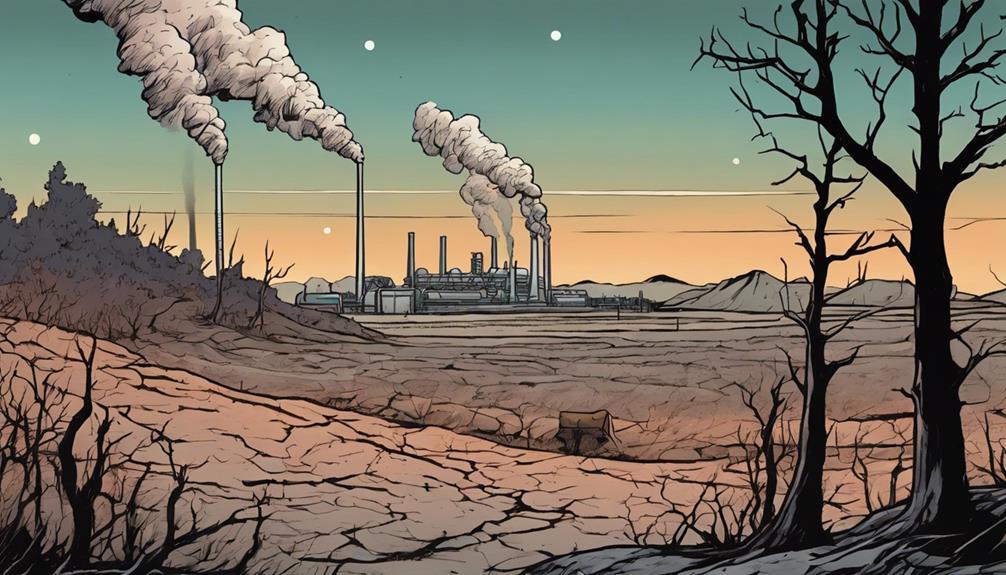
We're often led to believe that geothermal energy is a zero-carbon source, but the truth is, it's not entirely emission-free, and we need to address the greenhouse gas emissions that come with it. During drilling and extraction, geothermal energy releases carbon dioxide and other gases, contributing to global warming. While the carbon footprint of geothermal energy is lower than fossil fuels, it's crucial to recognize the environmental impacts.
| Emission Source | Description |
|---|---|
| Drilling | Releases carbon dioxide and other gases |
| Extraction | Contributes to global warming |
| Production | Has a carbon footprint, albeit lower than fossil fuels |
We must consider the overall environmental impact of geothermal energy to make informed decisions about our energy future.
Land Subsidence and Seismicity

Geothermal energy production can trigger land subsidence, a process where land surfaces sink due to changes in pressure from fluid extraction. This sinking can lead to seismic activity and other environmental concerns. We've seen it happen when hot water or steam is extracted from the Earth's crust, causing the ground above to sink.
This land subsidence can be further exacerbated by the injection of fluids back into the subsurface. What's more, seismic activity can be induced by geothermal energy production, which raises concerns about the stability of the surrounding environment.
As we explore the benefits of geothermal energy, we must also acknowledge and address these potential risks to guarantee a more sustainable future.
Water Pollution Risks Assessed
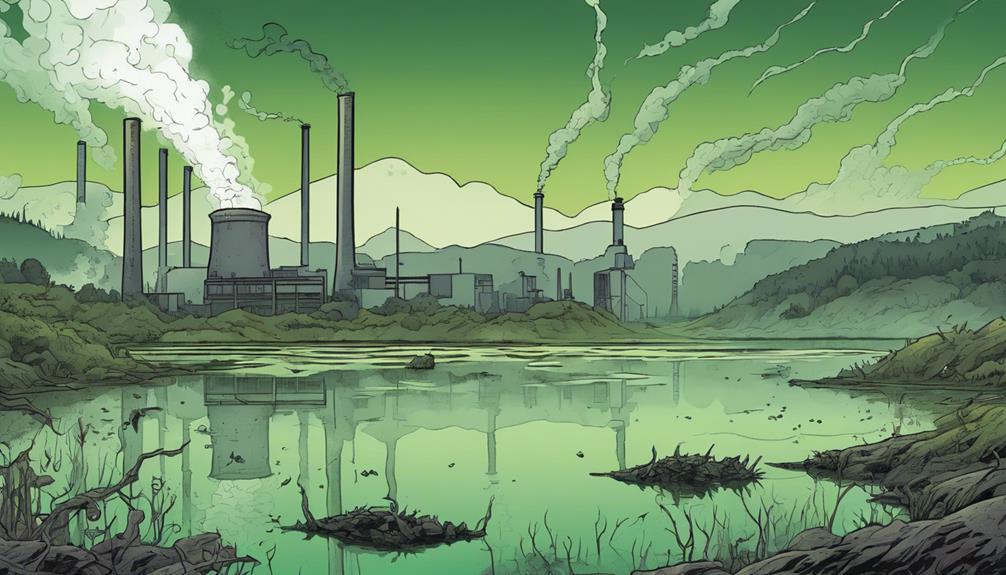
We've observed the environmental concerns surrounding land subsidence, but another significant issue arises when we extract hot water or steam from the Earth's crust: the risk of water pollution.
As we drill deep into the Earth, contamination risks increase, posing a threat to aquatic ecosystems. Cooling water withdrawal from geothermal power plants can harm aquatic organisms, and the discharge of geothermal fluids introduces harmful substances into water bodies.
It's crucial to recognize that effective measures are necessary to mitigate water pollution from geothermal energy. The consequences of geothermal fluid discharge can be severe, altering water pH levels, and introducing heavy metals and sulfates into water bodies, disrupting nutrient cycles in aquatic ecosystems.
It's vital that we grasp these risks to guarantee ecosystem stability.
Chemical Impacts on Ecosystems
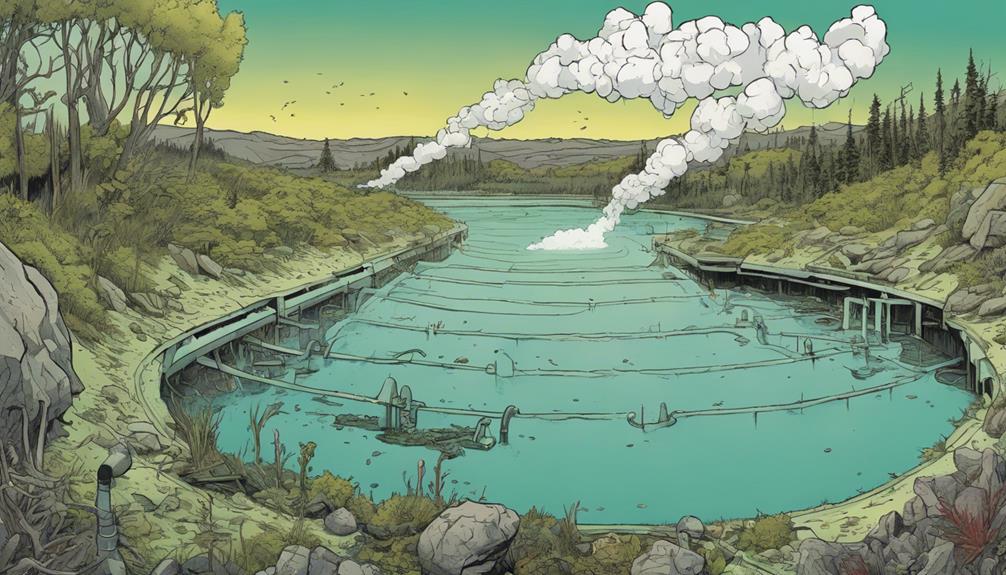
As we explore the environmental implications of geothermal energy, it becomes evident that the chemicals found in geothermal fluids can have extensive and devastating effects on ecosystems.
The release of geothermal fluids introduces harmful substances like heavy metals into water bodies, changing pH levels and disrupting nutrient cycles. This can result in the buildup of heavy metals and sulfates, leading to harm to aquatic organisms.
We need to recognize that geothermal energy production isn't as environmentally friendly as often stated. It's crucial to grasp the repercussions of geothermal fluid discharge to uphold ecosystem stability.
Noise and Visual Disturbances

Beyond the chemical impacts, our attention turns to the often-overlooked yet significant noise and visual disturbances caused by geothermal power plants, which can have far-reaching consequences for local ecosystems and human activities.
We've seen how these plants can impact tourism, deterring visitors seeking natural landscapes. The industrial infrastructure can be a visual eyesore, disrupting the natural beauty of the area.
Additionally, the noise from these plants can disturb the natural behaviors of wildlife, altering their migration patterns and reducing available habitat. It's essential we acknowledge these disturbances and take measures to minimize them, ensuring geothermal energy production doesn't come at the cost of environmental degradation.
Mitigating Geothermal Energy's Impacts
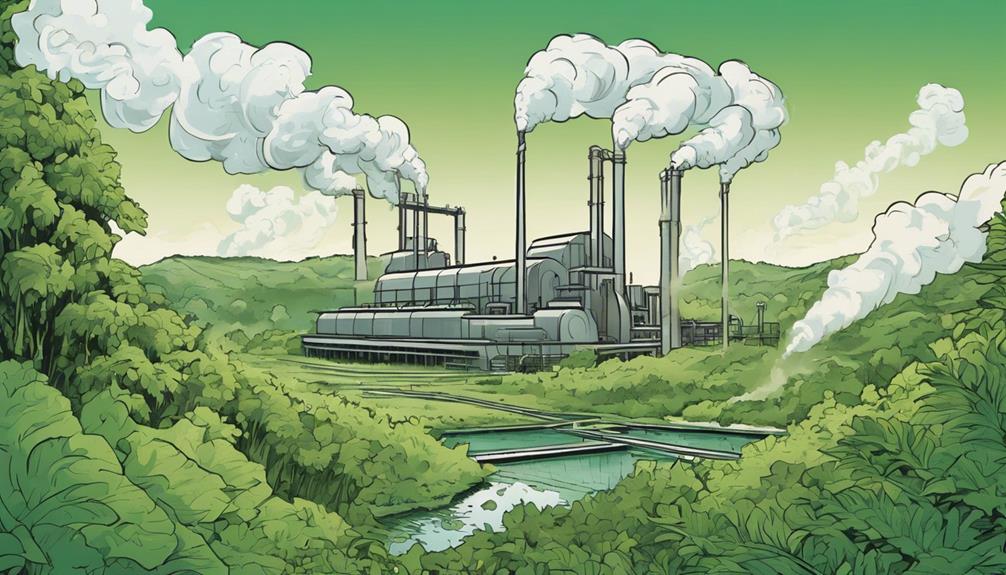
To minimize geothermal energy's environmental footprint, it's important that we implement effective measures to mitigate its impacts, from reducing greenhouse gas emissions to preventing water pollution and land subsidence. We must take a proactive approach to address these concerns.
Here are some strategies we can employ:
- Implementing carbon capture and storage technologies to reduce emissions
- Using closed-loop systems to minimize water pollution and land subsidence
- Conducting regular environmental assessments to identify potential risks
- Developing and enforcing strict regulations to guarantee responsible geothermal energy production
Frequently Asked Questions
Can Geothermal Energy Production Be Completely Environmentally Friendly?
"We thought geothermal energy was a silver bullet, but we've learned it's not completely environmentally friendly. Drilling, extraction, and production come with greenhouse gas emissions, land subsidence, water pollution, and noise and visual impacts."
How Does Geothermal Energy Compare to Other Renewable Energy Sources?
"We're not kidding when we say geothermal energy is a drop in the ocean compared to other renewables We considered it a holy grail, but it still has environmental drawbacks, making it less ideal than solar or wind power."
Are There Any Successful Cases of Mitigating Geothermal Energy's Impacts?
We're glad you asked about successful cases of mitigating geothermal energy's impacts – yes, there are Many countries, like Iceland and New Zealand, have implemented effective measures to minimize environmental effects and maximize benefits.
Can Geothermal Energy Be Used in Areas With Low Volcanic Activity?
We can explore geothermal energy in areas with low volcanic activity, like Saskatchewan, Canada, where sedimentary basins are utilized. Although challenges arise, innovative technologies can tap into these resources, making geothermal energy a viable option.
What Are the Policy Implications of Geothermal Energy's Environmental Impacts?
"We must consider the policy implications of geothermal energy's environmental impacts, acknowledging the trade-offs between renewable energy goals and potential harms. Stricter regulations and mitigation measures are essential to minimize its ecological footprint."
How Does California’s Geothermal Energy Potential Impact the Environment?
California’s geothermal energy potential has a positive impact on the environment. Utilizing this abundant resource reduces reliance on fossil fuels, lowering greenhouse gas emissions. Harnessing the power of California’s geothermal energy potential helps to combat climate change and promotes a cleaner, more sustainable energy future.
Conclusion
As we celebrate geothermal energy's potential to power our future, we're forced to confront the uncomfortable truth: our pursuit of sustainability has unintended consequences. Amidst the steam and grandeur of geothermal power plants, we find hidden dangers lurking beneath the surface.
Let's not be blinded by the promise of clean energy; instead, let's work to mitigate the harm and create a truly sustainable future, where progress and preservation coexist.
